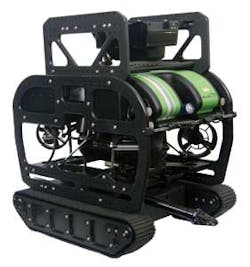MiniROVs benefit from vortex generators, Ethernet extension
David Conners
Enable-IT Inc.
A new, nimbler class of ROVs, called "miniROVs," is cutting and crawling a path through today's offshore oil and gas industry. These new tools not only match the capabilities of their larger, work-horse brethren for some tasks, but also can be superior for certain offshore applications such as work restricted spaces, hull inspections.
MiniROVs are larger than "micro ROVs," which have less thrust to work in currents and an available payload of only a single camera, lights, and perhaps one or two sensors. With their larger size, miniROVs can carry a broader, suite of sensors, tools, and other technologies.
MiniROVs are, however, smaller than standard observation-class ROVs, which generally requirelaunch and recovery systems (LARS). A miniROV requires no such system. It can be deployed and retrieved using its own tether, if the tether is strong enough. Some can handle a 100 kg (220 lb) payload.
Key miniROV technologies
MiniROVs were designed initially for shallow water, simply because there were a number of challenges that needed to be met before they could operate at depths greater than 1,000 m (3,048 ft). These included the miniaturization of control electronics, the design of lighter weight pressure housings, the need for power and data transmission over very long cable/tether/umbilical lengths, and more.
Over the past decade, the ROV industry has overcome these challenges to the point that miniROVs emulate many of the capabilities of larger systems. Additionally, some miniROV manufacturers have developed new technologies that have proven useful offshore.
Low drag tethers and Ethernet extension
Tethers become a problem for all ROVs indeepwater. The longer, thicker, and coarser an ROV's tether is, the greater its cumulative drag and, therefore, the greater the thrust the ROV requires to maneuver reliably.
Smoothening a tether is a non-issue, as cable sheathes are now rather smooth, but thinning the cross-section of a tether has been a difficult proposition. MiniROVs must transmit and receive many signals, and, sometimes, a considerable amount of power. This requires layers of wiring, shielding, and fiber.
Now, however, largely thanks to Ethernet extension technology, the cross-section of tethers has narrowed to 8.99 mm (0.345 in.), considerably narrower than traditional ROV tethers which may average 20 mm (0.787 in.). Once Enable-IT Inc., inventors of Ethernet extension technology, was able to miniaturize deep sea-worthy Ethernet extenders, miniROV manufacturers have been able to multiplex transmissions and send power over Ethernet (PoE) to miniROVs using one to two pair of standard copper wiring. These Ethernet extenders can seamlessly drive this data and power many thousands of feet, well past the regular Ethernet's distance limit of 100 m (328 ft), with no bridging in between. This means fewer wires and results in a thin, all-copper tether that exerts less drag on the miniROV. This also means a miniROV can often be lowered into the water by hand, without the need for a launching system.
Vortex generators
Another advancement is the non-magnetic vortex generator, which, when used as part of a "crawler" attachment, allows miniROVs to crawl pipelines, hulls, and other structures. Using an impeller instead of magnets or thrusters, vortex generators create a low-pressure pocket (venturi effect) beneath the crawling miniROV, yielding up to 28 kgf (kilogram force), or the equivalent of a 62-lb force of attraction against any flat, hard surface.
Such a system holds several benefits. It yields sufficient attractive force to maintain precise operations while a vessel is in motion at sea or is experiencing strong currents while anchored. This allows operators to survey vessels more safely and economically than by using dive teams, particularly in more hostile environments. It also means cameras and other equipment such as imaging sonar produce high quality images and data, because these devices are kept at a consistent distance from the target structure. Furthermore, with such stability, miniROV operators experience less fatigue.
Displaying 1/2 Page 1,2, Next>
View Article as Single page

